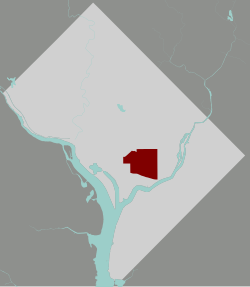Capitol Hill, Washington, D.C.
|
Capitol Hill Historic District
|
|

G Street SE
|
|

Map of Washington, D.C., with the Capitol Hill Historic District highlighted in maroon
|
|
| Location | Roughly bounded by Virginia Ave., SE., S. Capitol St., G St. NE., and 14th Sts. SE & NE; and roughly bounded by 8th St. NE, I-295, M St. SE and 11th St. SE Washington, D.C. |
|---|---|
| Coordinates | 38°53′23″N 77°00′40″W / 38.88972°N 77.01111°WCoordinates: 38°53′23″N 77°00′40″W / 38.88972°N 77.01111°W |
| Website | http://www.aoc.gov/explore-capitol-hill |
| NRHP Reference # |
76002127 (original) 03000585 (increase) |
| Significant dates | |
| Added to NRHP | August 27, 1976 |
| Boundary increase | July 3, 2003 |
Capitol Hill, in addition to being a metonym for the United States Congress, is the largest historic residential neighborhood in Washington, D.C., stretching easterly in front of the United States Capitol along wide avenues. It is one of the oldest residential neighborhoods in Washington, D.C., and with roughly 35,000 people in just under 2 square miles (5 km2), it is also one of the most densely populated.
As a geographic feature, Capitol Hill rises near the center of the District of Columbia and extends eastward. Pierre L'Enfant, as he began to develop his plan for the new Federal City in 1791, chose to locate the "Congress House" on the crest of the hill, facing the city, a site that L'Enfant characterized as a "pedestal waiting for a monument".
The Capitol Hill neighborhood today straddles two quadrants of the city, Southeast and Northeast, and a large portion of it is now designated as the Capitol Hill Historic District. The name Capitol Hill is often used to refer to both the historic district and to the larger neighborhood around it. To the east of Capitol Hill lies the Anacostia River, to the north is the H Street corridor, to the south are the Southeast/Southwest Freeway and the Washington Navy Yard, and to the west are the National Mall and the city's central business district.
The Capitol Hill Historic District was expanded in 2015 to the north to include the blocks bordered by 2nd Street, F Street, 4th Street, and just south of H Street, NE, collectively known as the Swampoodle Addition.
...
Wikipedia
